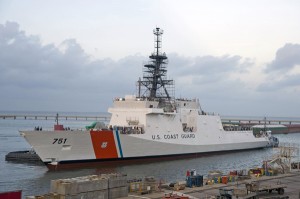The Coast Guard has finished investigating a Bering Sea rescue that left a 28-year-old crewman with fatal head injuries late last year.
According to a review board, faulty equipment and work practices developed by the crew of the cutter Waesche put Petty Officer Travis Obendorf in harm’s way.
Obendorf and the rest of the Waesche crew had been on patrol in the Bering Sea for three months when they were called to help the Alaska Mist. It was a large fishing vessel that lost propulsion and started drifting near Amak Island.

The Waesche reached the fishing boat on November 11. Chief Warrant Officer Allyson Conroy says the situation was urgent.
“They had 22 mariners on board; they were disabled,” Conroy said “The Coast Guard needed to get the non-essential personnel off the Alaska Mist.”
Although they had access to a helicopter, Conroy says the Waesche crew wanted to send their rescue boat to pick up the crew. It’s a 24-foot inflatable Zodiac, with hard sides.
Conroy says the crew conducted a risk assessment of their rescue plan.
“With this particular mission, they had already done so many small boat operations in the environment that they were in on November 11 that they were more concerned about rescuing these people, and they were comfortable with conducting the operation,” Conroy said.
The Waesche had used the small boat 130 times during their patrol in the Bering Sea. It always went smoothly – except for the fact that the boat launch and recovery system was broken.
It was a capture net and line, designed to snag the rescue boat when the crew it back into its compartment at the back of the cutter. The system was supposed to secure the vessel without any human intervention.
But on the Waesche, it only worked about 40 percent of the time. The other two national security cutters also had problems with this system, but not as consistently.
Chief Warrant Officer Conroy says the cutters formally requested improvements to the boat capture system about four years ago.
“The safety implications were not evident at that particular time,” Conroy said. “Of course, retrospectively, the changes were incorrectly prioritized among numerous high-priority configuration change projects.”
In the meantime, the Waesche decided to work around it.
Conroy says they started posting a crew member at the very front of the small rescue boat. That person would manually secure the vessel after a mission. It wasn’t common practice, but it worked – until it was time to rescue the Alaska Mist.
Petty Officer Travis Obendorf – a 28-year-old Idaho native – was assigned to sit at the front of the rescue boat. They gathered five non-essential fishermen off the Alaska Mist and started to take them back to the Coast Guard cutter.
According to the Coast Guard’s investigation report, they faced rough seas – worse than what the rescue boat was rated to operate in. That made it hard steer the back into the compartment aboard the Waesche.
The rescue boat was halfway inside when a series of swells washed in behind it. The boat slid underneath the capture net, and the net shoved Obendorf backwards. He was slammed into the center console of the rescue boat and lost consciousness.
Obendorf had been wearing a helmet, but he still had severe head injuries. A medical crew aboard the Waesche responded as soon as possible, and Conroy says they called for a medevac.
“He was then medically evacuated from the Waesche and taken to Cold Bay,” Conroy said. “From Cold Bay he was taken to Anchorage; after Anchorage, he was then transported to Seattle for continued care.”
“And then, on December 18, he died in a Seattle hospital.”
Conroy says the Coast Guard started making changes to its national security cutters almost immediately after Obendorf was injured. They got rid of the rescue boat that the Waesche crew had been using and replaced it with a slightly larger model.
“There’s also been guidance put out that commanding officers are not to put any crewman forward of the center console, which is what happened in the incident with Petty Officer Obendorf,” Conroy said.
But Conroy says that within a few months, there shouldn’t be a need to put crew members in that position anymore. The Coast Guard is going to fix the system for launching and recovering rescue boats from cutters, so it’s fully automatic.
The repairs are similar to what the national security cutters requested back in 2010. And Conroy says that fact has prompted the Coast Guard to rethink the way they prioritize upgrades to their fleet.
“They are taking a closer look at the recommendations that are coming into the field, and specifically looking to see if they have a safety aspect and reevaluating those recommendations,” Conroy said.
In the end, Conroy says the Coast Guard is not taking disciplinary action against any personnel connected to the rescue operation or the accident. And Conroy says there haven’t been any lawsuits related to it, either.




